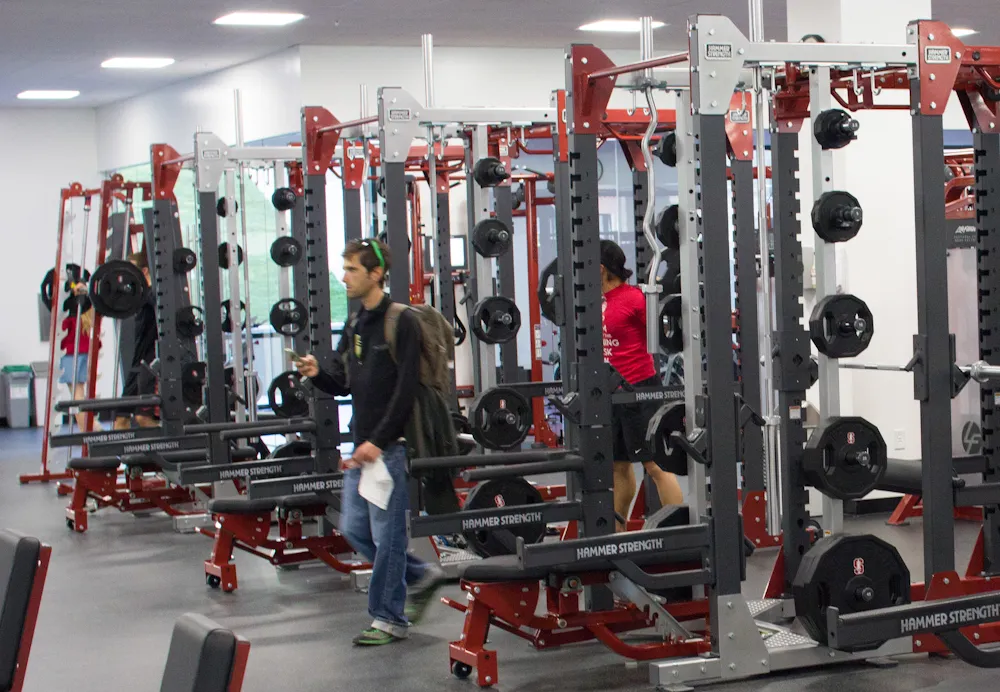Editor’s Note: Since the publication of this article, a debate has arisen as to the potential discriminatory nature of the women-focused sessions under Title IX. University spokesperson EJ Miranda wrote in an email to The Daily that “all community members may drop in any time the studio is open (regardless of gender focus). No one is being banned because of gender.” A follow-up article is forthcoming.
Arrillaga Outdoor Education and Recreation Center (AOERC) is now offering a new resource: women’s-only training hours, on Mondays and Wednesdays from 1 to 3 p.m.
The idea was conceived by Jennifer Sexton, director of fitness and wellness programs, and Daralisa Kelley, associate director of recreation programs, who are both Inclusivity Committee Chairs of the Stanford Recreation and Wellness department.
Sexton and Kelley jump-started the idea after hearing feedback from Stanford women who didn’t feel comfortable in large gym spaces. The idea also spurred from broader efforts by an inclusivity committee created a year ago to understand the needs of different communities by reaching out to various partners across campus.
In response to the feedback they received, Sexton and Kelley created women’s-only training hours with the hope that the hours create a private, women’s-only space – which was also created specifically to be trans-inclusive.
The lifting hours take place in AOERC room 112, where the windows have blackout shades and there are partitions by the glass entry doors — ensuring privacy for all women and trans-women who are exercising.
Irina Vitman, one of the personal trainers available during the training hours, lauded the new space for its inclusivity.
“[It’s a] safe space to make [women] feel more comfortable, so that there’s no guys ‘macho-ing’ around,” said Vitman. “It’s a little less intimidating to use the free weights.”
Trainers like Vitman lead guided workouts from 1 to 1:30 p.m., and are available during the whole three-hour period to answer questions, teach women how to use equipment, give advice and suggest workouts.
According to Marina Dimitrov ’18, a mechanical engineering co-term who started going to the training hours last week, the personal trainers ensure everyone has a positive workout experience by providing women with individualized attention. Since the space is comparatively small, and there are usually only 15 to 20 participants during peak times, the trainers have the chance to work with people on a one-on-one basis, said Dimitrov.
“Generally I’m not a gym person at all, but this space is just nice,” Dimitrov said.
According to Sexton and Kelly, the training hours aim to target women like Dimitrov, who don’t necessarily consider themselves “gym people.”
When it comes to using gym equipment, lack of experience proved prohibitive for many women.
“It’s really hard if you don’t know where to start,” Vitman said. “We try to teach women to use equipment that they would generally not use.”
Camille Townshend ’18, a mechanical engineering co-term, echoed Vitman’s sentiments. According to Townshend, when she first started lifting, she did not feel comfortable in the gym environment.
“Everything was being used and all the testosterone in the air was super suffocating — the kind of culture you find in the gym, it feels very aggressive and not very welcoming,” Townshend said.
Townshend went on to say that the women’s training hours feel different than regular gym hours.
“It was a very welcoming way to start lifting,” she said. “And now I’ve been doing it for three weeks.”
Since the training hours are a recently-introduced campus resource, its long-term future still remains unknown. But Kelley welcomes all feedback about the program and how it may better serve Stanford’s community.
“We hope to continue this programming through the coming quarters,” Kelley said. “Since the offering is in its infancy, we are assessing the initial participation and feedback before we decide to make any modifications.”
But so far, the feedback seems positive.
“It’s actually gotten to the point where I don’t go to the gym if it’s not 1 to 3 on Monday or Wednesday,” Townshend said. “I mean, I’ve never had a workout schedule, and now I do.”
Contact Adesuwa Agbonile at adesuwaa ‘at’ stanford.edu.
Correction: An earlier version of this article incorrectly stated that the lifting hours were created because gym equipment can be confusing and difficult to use for beginners. It has been updated to reflect that lifting hours were created to increase inclusion, and many participants are advanced lifters. The Daily regrets this error.
